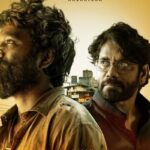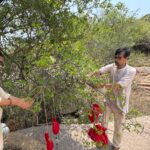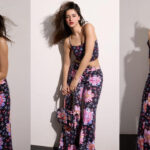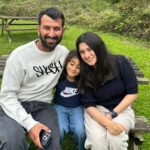Youth4jobs Empowers the Disabled Photographers by Recognizing Their Talent for Visual Storytelling
8 Indian photographers with disabilities won the Global Ability Photography Challenge(GAPC) held by Youth4Jobs Foundation in partnership with the Indian Photo Festival in its 9th edition which took place in November 2023. Youth4Jobs is a not-for-profit organisation, dedicated to training and enabling means of livelihood for youth with disabilities. “This is a very special event, we feel that people with disabilities should be recognised in society—we are the largest in South Asia in training and employment, but what I feel very strongly is it’s necessary to also hone their creative skills, that’s why we do events like this, we believe that that actually makes a person whole, and try to convince the various stakeholders that it’s extremely important,” expressed Meera Shenoy, Founder of Youth4Jobs.
It invited photographers with disabilities to submit their work—269 participants, 18 disabilities, 20 finalists and 8 winners—the first and second winners received a cash prize of INR 25000/-, while the others received INR 15000/-. With the support of US Consulate Hyderabad, the award ceremony was graced by Nolan Ryan-Trowe, a multidisciplinary artist from California, a photographer with disability himself, and a 2024 Light Work Artist in Residence. An Art Talk and a Masterclass Photography Workshop by Nolan Trowe were scheduled, and his photo essay “Revelations in a Wheelchair” are exhibited alongside the photographs of the 20 finalists.
In the Art Talk, Nolan shared his experience and insights on being an artist and photographer with disability, and answered questions posed by a curious audience. The power of storytelling was the theme in his address, which was later explored in detail during the Q & A session.
Nolan, who pursued photography after his spinal cord injury in 2016, during his graduate studies in New York, began by recalling how photography was not a planned pursuit, and how he ended up telling the stories of the disabled community, through photographs. “I am lucky that my mentors came forward and told me that my community is never really seen visually, that I should be telling these stories, and I realized I could use visual arts as a means to communicate. So these photos were me telling stories about my friends and my community. That’s what led me to photography, telling stories.”
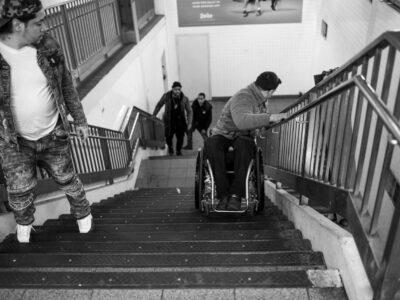
Nolan’s friend going down the stairs on his wheelchair—”I was so used to seeing it, I didn’t realise how dangerous it was, how inaccessible the city was.”
True to that, Nolan’s photographs show beautiful moments of love and care shared between people, disabled or not. “When people show disability, it is seen in a negative light—they are shown with pity; people don’t really understand disability. So I really wanted my photographs to show as normal, everyday moments of love. It is more about the people. People in the disabled community deal with a lot of inaccessibility, struggle and pain everyday, but in between all of that, there are a lot of normal moments of beauty, normal people that don’t have to be pitied, or looked down upon. We are all people with shared humanity, and that was something important to me. When I put together my photographs to tell a story, it had an impact. It actually led to some changes in New York through the subway systems.”

Nolan’s friend Nadia with her children—”She has cerebral palsy. People were telling her she should not be a mother, that it’s wrong for her to have a child. As you can see, she is a great mother, she really loves her daughter.”
In a word of encouragement to photographers in the disabled community, Nolan noted that he saw no difference between the works of non-disabled and those of the disabled artists exhibited in the Indian Photo Festival. “We are all trying to tell human stories, to communicate emotion. Photography can be a good means to do that. Sadly, there’s not a lot of visual storytellers with disabilities, globally. I have come all the way to see an exhibition of photography by people with disabilities—it is really inspiring to me to see it thriving, because you don’t see it that much.”

“My friend took this picture of me to show my process of photographing.” – Nolan
Going further, he said “the more personal you can make your narrative, the more you can show your life. You never really know where those stories, those photographs are going to lead you. I think the more you can take photographs, string them together, you start to see a narrative coming your way.”
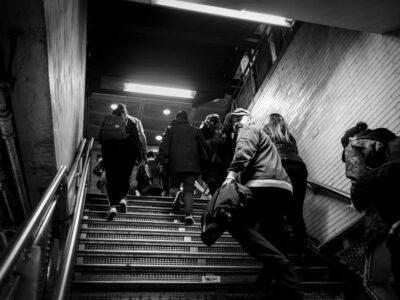
“People have constant eyes at me because I am a wheelchair user. I use the camera to combat that. I use it as a mirror to show people they are looking at me. It makes them uncomfortable to be objectified. When you can use the camera to reflect these things back on people, I think that’s really powerful.” -Nolan
Nolan’s address for this special segment of the Indian Photo Festival ended with an emphasis on the importance of a narrative about the disabled community, coming from within the community. “It is a really small community, so if we encourage each other to tell our story, that’s the most important thing we can do, because no one else is going to tell these stories. For disabled people, travelling can be a nightmare, there is a lack of facilities, and education systems and job sectors are inaccessible, globally. Even in America, there aren’t many accessible jobs. I have a hard time finding employment. The more you can tell your stories, the more you can show what’s going on in your life, I think people will pay attention—because today we are such a visual society. So you’d be surprised at the impact one photo, one story, one post on social media, or an exhibition like this, can have. It’s impossible to know how far it can go.”
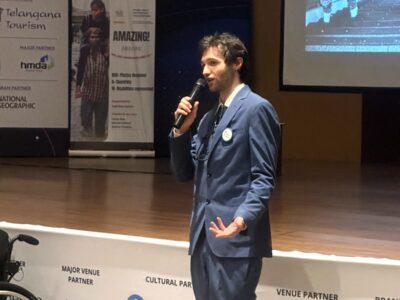
Nolay Ryan-Trowe delivering the keynote address at the Global Ability Photography Challenge Award Ceremony as part of the Indian Photo Festival 2023
In response to the questions about photography and storytelling from the audience, which included disabled youth, their parents and community volunteers, Nolan gave the following advice:
(1) Formal training is beneficial but not essential, mostly for the connections it can enable for getting published
(2) Whether photographing disabled people or non-disabled people, avoid assuming what they need, and ask them; and to feel a connection, and to really want to tell that story
(3) While the deaf and dumb community may find it difficult to communicate with fellow photographers, they would benefit from focusing on how their photographs talk to each other, and forming a narrative
(4) Children with disabilities can learn to tell a story with the help of picture books for children where they can understand how pictures in a sequence work to tell a story
(5) There is no wrong photograph, and there is no need to focus on what’s right or wrong. One might not like their shot now, they might like it later, and might use it later. It’s all about which photographs tell best the story one wants to tell.
After the Art Talk, the eight winners of the Global Ability Photography Challenge received trophies and cash prizes from the hands of Nolan Ryan-Trowe. The segment was organised with an intention to recognise photographers with different disabilities. The winning entries were selected by the judging team of Nishat Fatima, Vicky Roy and Sesino Yhoshu.
The inspiring talk was followed by a Photography Masterclass with Nolan Ryan where he shared insights on how to make a personal photo essay with a focus on human rights.
The photographs which won the Global Ability Photography Challenge.

“Young girl” by Lavanujan Croos (Speech and Hearing Impairment)—I found this girl inside the temple to be stunning, she seemed to want a goal for her future, and respect for religion.

“The soul of India lives in its village” by Akanksha Kamble (Speech and Hearing Impairment)—I was inspired by how people from the village feel comfortable to sit on the ground.

“Caught” by Gayatri Gupta (Down Syndrome)—A moment of frustration and prayer, caught during the peak of CoVid, Gayatri took the shot and told her mother “I caught you between the buildings and Covid!”

“The beauty of the masked face” by Aravind (Speech and Hearing Impairment)—When I saw how this child agreed to have his face painted allowing us to connect and engage with him on a deeper level, I felt I understood the meaning of equal opportunity, and I captured that moment.

“Lightning” by Awinash Anant Kulkarni (Paraplegia)—after spending hours to capture the sight of lightning, I finally did it!

“Sunset” by Awinash Anant Kulkarni (Paraplegia)—
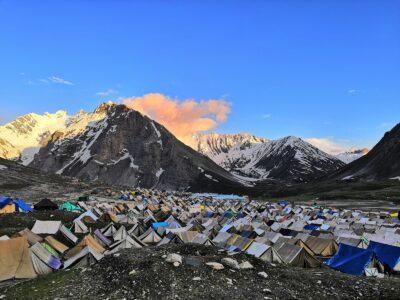
“India from my eyes-incredible!” by Deepanshi Sharma (Locomotor)—Inspired by the colourful tents and the beautiful smiles of the people headed to the annual pilgrimage known as Amarnath Yatra which is the source of livelihood for the struggling Kashmiri population.

“Celebrations” by Raji Reddy (Locomotor)—The group of women holding lights during a wedding procession echoed the collective glow of the celebrating party, encapsulating the shared joy, hope, and the promise of a new chapter.

“Pillars of Faith” by Syed Azhar Hussain (Speech and Hearing Impairment)—While basking in the tranquility of the time of Ramzan in Jama Masjid, New Delhi, I was inspired by the symmetry of the pillars, standing tall, and shot a small part of a magnificent structure that symbolises history, culture and faith of the City of Delhi.








